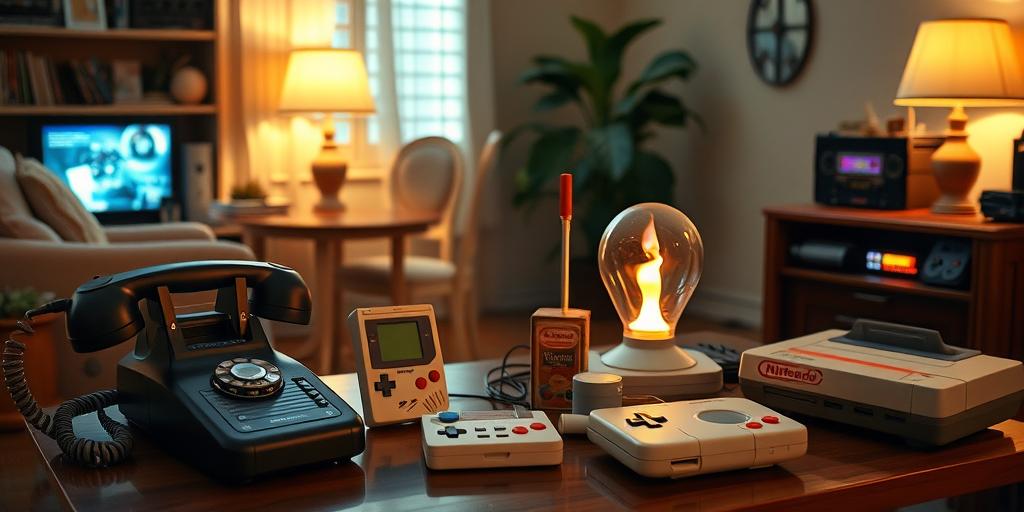Remember the days of spending hours lost in the world of video games, building elaborate creations with your trusty LEGO set, or excitedly flipping through the channels on your bulky TV? These were the days of our childhood, filled with the wonder and excitement of discovering new gadgets that shaped our lives and sparked our imaginations. From the dawn of digital entertainment to the rise of the mobile revolution, each generation of childhood gadgets has played a vital role in shaping our digital world.
Introduction: A Trip Down Memory Lane
As we navigate the ever-evolving landscape of technology, it’s easy to forget the simple joys of the gadgets that defined our childhood. These devices were more than just pieces of technology; they were gateways to new worlds, sources of endless entertainment, and tools that fostered creativity and learning. Whether it was the thrill of conquering a new level on your Atari console or the satisfaction of building a sprawling city with your LEGO bricks, these experiences left an indelible mark on our lives. In this nostalgic journey, we’ll revisit the most iconic gadgets that shaped our childhoods, exploring their impact on our digital lives and the enduring legacy they left behind.
The Dawn of Digital Entertainment: From Pong to Pac-Man
The 1970s ushered in a new era of entertainment with the arrival of video games. The first arcade games, like Pong and Pac-Man, captivated audiences with their simple yet addictive gameplay. These early games, often found in arcades and bars, were a social experience, bringing people together to compete and share in the excitement.
The Rise of Arcade Games
The emergence of arcade games like Space Invaders, Donkey Kong, and Galaga marked a turning point in the gaming industry. These games featured more complex gameplay, vibrant graphics, and innovative mechanics that pushed the boundaries of what was possible with digital entertainment. Arcades became hubs of activity, filled with the sounds of beeping, buzzing, and cheers as players battled for high scores and bragging rights.
Home Consoles: Atari and Nintendo Take Over
The success of arcade games paved the way for the rise of home consoles. The Atari 2600, released in 1977, brought arcade-style gaming into living rooms, revolutionizing the way people experienced entertainment. With iconic titles like Pac-Man, Space Invaders, and Donkey Kong, the Atari 2600 quickly became a cultural phenomenon. The arrival of the Nintendo Entertainment System (NES) in 1985 further solidified the home console market. The NES introduced new features like advanced graphics, sound, and game cartridges, offering a wider range of gaming experiences for players of all ages.
The Personal Computer Revolution: From DOS to Windows
The late 1970s and early 1980s saw the emergence of the personal computer (PC). Initially designed for businesses and professionals, PCs quickly found their way into homes, transforming how people worked, learned, and communicated. These early PCs, often with clunky interfaces and limited capabilities, paved the way for the sophisticated machines we use today.
The Early Days of Home Computing
The Apple II, released in 1977, was one of the first commercially successful personal computers designed for the home market. It featured a user-friendly interface, a powerful processor, and a wide range of software that made it ideal for education, business, and entertainment. The IBM PC, released in 1981, became the industry standard, leading to a surge in PC adoption.
The Impact of the Internet
The development of the internet in the 1990s revolutionized the way people used computers. The internet provided access to a vast amount of information, enabled instant communication across the globe, and opened up new possibilities for entertainment and commerce. The introduction of graphical user interfaces like Windows made computers more accessible to the general public, further fueling the PC revolution.
The Mobile Revolution: From Brick Phones to Smartphones
The early days of mobile phones were marked by bulky devices with limited capabilities. These “brick phones,” as they were often called, were primarily used for making calls and sending text messages. The introduction of the first smartphones in the late 1990s and early 2000s marked a turning point in mobile technology, ushering in an era of mobile computing and connectivity.
The First Mobile Phones: A Luxury Item
The first mobile phones, like the Motorola DynaTAC 8000x, were expensive and bulky, making them a luxury item for the wealthy. These early phones were primarily used for making and receiving calls, with limited features like text messaging and basic games. However, the convenience of being able to communicate from anywhere sparked a rapid increase in mobile phone adoption.
The Rise of the Smartphone: A Pocket Computer
The introduction of the first smartphones, like the IBM Simon Personal Communicator, changed the way people interacted with technology. These devices combined the functionality of a mobile phone, a pager, and a personal digital assistant, providing access to email, internet browsing, and other applications. The development of the touchscreen interface and the introduction of app stores further expanded the capabilities of smartphones, transforming them into pocket computers.
The Legacy of Childhood Gadgets: Shaping Our Digital World
The gadgets that defined our childhoods have left an enduring legacy, shaping the technology we use today. These devices fostered our curiosity, sparked our imaginations, and introduced us to the possibilities of the digital world.
The Impact on Technology Today
The advancements in video game technology, personal computing, and mobile devices that we witnessed during our childhoods continue to shape the technology landscape. The innovations in graphics, processing power, and connectivity that were pioneered in these early gadgets have paved the way for the powerful devices we use today.
The Importance of Nostalgia in Our Digital Lives
In our fast-paced digital world, it’s important to remember the simple joys of the gadgets that defined our childhoods. These devices offer a nostalgic glimpse into the past, reminding us of the power of creativity, play, and exploration. As we continue to navigate the ever-evolving digital landscape, these experiences provide valuable insights into the evolution of technology and the lasting impact it has on our lives.
The gadgets of our childhood may have evolved and become more sophisticated, but their spirit lives on in the technology we use today. Whether it’s the joy of playing a video game, the satisfaction of creating something new on a computer, or the convenience of staying connected through a smartphone, these experiences continue to shape our digital world and remind us of the magic that technology can bring.




